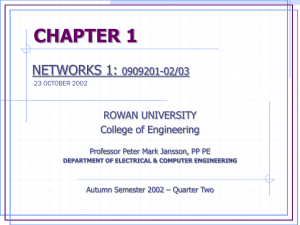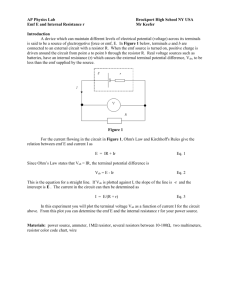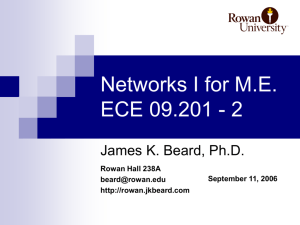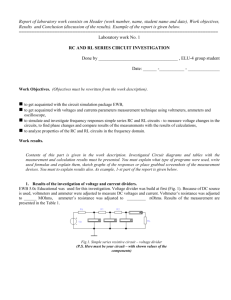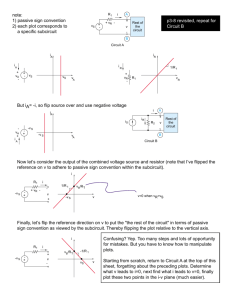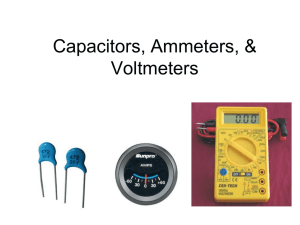chapter 2 - s3.amazonaws.com
advertisement
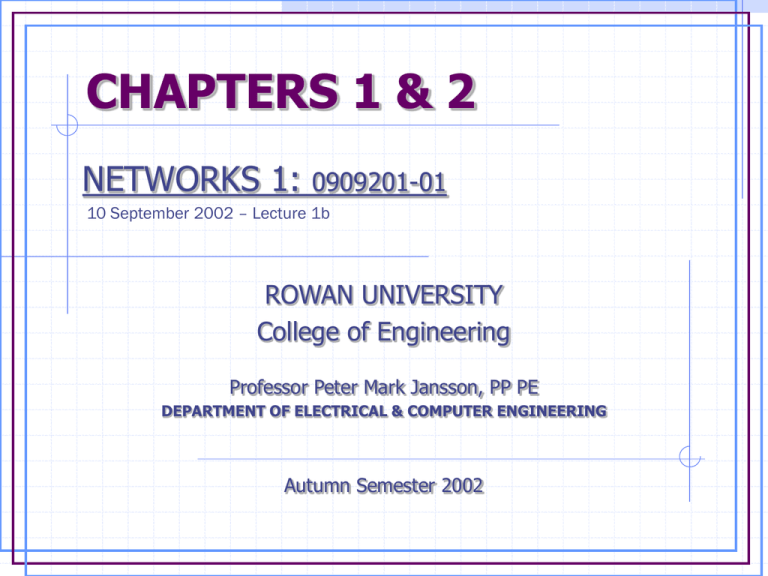
CHAPTERS 1 & 2 NETWORKS 1: 0909201-01 10 September 2002 – Lecture 1b ROWAN UNIVERSITY College of Engineering Professor Peter Mark Jansson, PP PE DEPARTMENT OF ELECTRICAL & COMPUTER ENGINEERING Autumn Semester 2002 Text is In Bookstore: Required Text : Introduction to Electric Circuits 5th Edition Dorf and Svoboda Assigned Reading per Syllabus Chapters 1 & 2 One-Minute Papers - summary passive sign convention (3) little fast, too quickly on slides (2) energy vs. power (2) voltage vs. current (defn. & calcs) (2) voltmeter & ammeter operation (2) no syllabus? solving a circuit w/ resistors unit conversion remembering the calculus Networks I Today’s Learning Objectives – Define circuit elements Analyze electrical circuits Apply circuit parameters (v, i, r, p, etc.) Analyze DC circuits with passive elements including: resistance chapter 1 – overview history of electricity - done electric circuits and current flow systems of units - done voltage power and energy voltmeters and ammeters circuit analysis and design electric circuits & current flow Current is the time rate of flow of electric charge (q) past a given point Use lower case to indicate a time varying current and upper case to indicate a constant or direct current dq i dt i1 i2 i1 i2 voltage The voltage across an element is the work (energy) required to move a unit positive charge from the - terminal to the + terminal. a b dw v dq a + vab - - vba + vab vba b voltage / current analogy mechanical system analogy: pump, fluid pressure (head), velocity battery, voltage, current high pressure (head) high voltage increased fluid flow high current increasing either: increases power circuit analogy envision a closed system of water flowing in troughs pumps elevate the head of the flow and increase its velocity in various troughs flow of mass is conserved energy can be added (pumps) or extracted (waterwheels) though overall system of water flow is conserved energy is transferred by head and velocity in a given part of circuit flowrate is constant power Power is the rate of expending energy. Power absorbed by an element is positive, Power delivered by an element is negative. i a b i a + vab - - vba + dw dw dq p vi dt dq dt b passive sign convention (psc) positive current flows from positive voltage to negative voltage. + vab - i a b i a vab + b Is the current in Is the current in this resistor positive this element positive or negative? or negative? power and psc p=v•i Power is absorbed by an element adhering to the passive sign convention (sink) + vab i a b Power is supplied by an element not adhering to the passive sign convention (source) i a vab + b power and psc example what is the power absorbed or supplied by the element below, when i = 4A? i a vab = 12V + b power = 12V x 4A = 48 W does not adhere to passive sign convention, so power is supplied. power and psc quiz what is the power absorbed or supplied by the element below, when i = 4A? i a vab = 12V + b power = 12V x 4A = 48 W does not adhere to passive sign convention, so power is supplied. power and energy p=v•i power = voltage * current power is the time rate of expending energy w 0 pdt t energy = power * time energy is the capacity to do work power and energy energy = force x distance power = energy / time period (secs) power and energy example a mass of 300 grams experiences a force of 200 newtons. Find the energy (or work expended) if the mass moves 15 cm. Also find the power if the move is completed in 10 milliseconds. energy = force x distance (N • m) energy = 200 x .15 = 30J power = energy / second (J/sec=Watts) power = 30J/10-2 sec = 3000W = 3kW power and energy quiz a Motorola StarTAC cellular phone uses a small 3.6V lithium ion battery with nominal stored energy of 200 joules. For how long will it power the phone if it draws a 3-mA current when in operation? quiz solution 200 joules = 200 watt-secs 3.6 V x 3 mA = 1.08 x 10-2 watts 200 watt-secs / 1.08 x 10-2 watts = 18,519 seconds 18,519 seconds / 3600 sec/hr = 5.1 hours voltmeters and ammeters dc current and voltage measurements are made with (analog or digital type) ammeters and voltmeters voltage measurements are made with red probe (+) at point a, and black probe (-) at point b + i a vab b voltmeters and ammeters current measurements require breaking into the circuit so the ammeter is in series with the current flow made with red probe (+) at point b, and black probe (-) at point c + i a vab bc ideal meters ammeters – negligible voltage drop through it voltmeters – negligible current flows into it circuit analysis and design analysis – concerned with the methodological study of a circuit to determine direction and magnitude of one or more circuit variables (V, A) problem statement situation and assumptions goal and requirements plan act verify if correct, solved if not, plan act verify iterate as needed chapter 2 - overview engineering and linear models active and passive circuit elements resistors – Ohm’s Law independent sources dependent sources transducers switches
